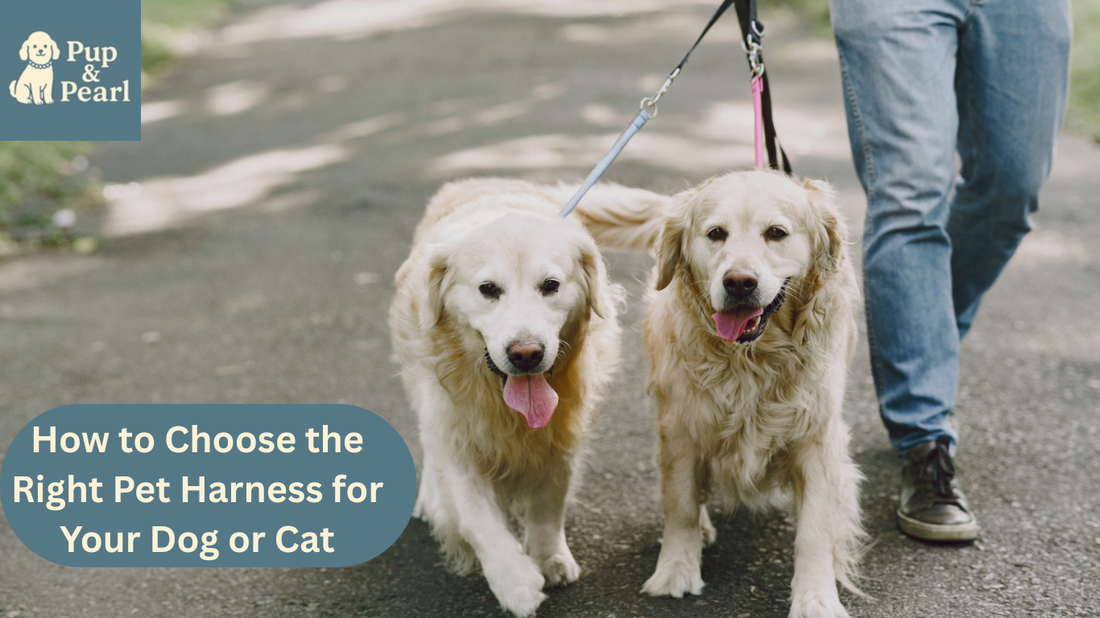
How to Choose the Right Pet Harness for Your Dog or Cat
Share
Introduction: Why a Harness Matters More Than You Think
At PupandPearl, we believe that the right harness is more than an accessory it’s a lifeline of safety, comfort, and communication between you and your pet. Whether you’re walking your energetic dog or taking your curious cat on an outdoor adventure, the correct harness ensures security without sacrificing comfort.
Understanding the Difference Between Collars and Harnesses
While collars are traditional, they can place pressure on the neck and trachea, especially for pets that pull or lunge. A harness distributes pressure across the chest and shoulders, reducing strain and allowing better control. This design not only enhances safety but also promotes healthier, stress-free walks.
The Benefits of Using a Harness for Dogs and Cats
Harnesses prevent choking and neck injuries, particularly for smaller breeds or cats with delicate frames. They provide improved guidance, helping pet owners manage pulling, sudden movements, or escape attempts. For cats, harnesses make outdoor exploration possible without the risk of slipping out of a collar.
Key Factors to Consider Before Buying
Before selecting a harness, assess your pet’s behavior, body type, and activity level. Think about where you’ll use it city sidewalks, hiking trails, or backyard strolls. Durability, adjustability, and ease of use are key aspects that influence long-term comfort and performance.
Measuring Your Pet Correctly
Accurate measurements ensure a secure, comfortable fit. Use a soft measuring tape to measure your pet’s neck girth, chest girth, and body length. Always leave enough room for two fingers between the harness and your pet’s body to prevent restriction while maintaining control.
Types of Pet Harnesses
Step-In Harness
Perfect for calm pets, this design allows your dog or cat to step into the harness before it’s fastened around the back. It’s easy to use and gentle on the body.
Vest Harness
Made from soft, padded materials, the vest harness wraps around the torso for a snug, secure fit. It’s ideal for small dogs and cats, offering comfort and reduced rubbing.
Back-Clip Harness
The D-ring on the back makes it simple to attach a leash and is excellent for trained pets. It provides freedom of movement but offers less control for heavy pullers.
Front-Clip (No-Pull) Harness
This design helps manage pulling behavior by redirecting forward motion to the side, encouraging pets to walk beside you rather than ahead. Excellent for training and energetic dogs.
Dual-Clip Harness
Featuring both front and back clips, this type offers maximum versatility. You can switch between control and comfort depending on the walking situation.
Cat-Specific Harnesses
Designed with flexibility and lightness in mind, cat harnesses are escape-proof and soft. They typically use Velcro closures or secure buckles to prevent slipping out during exploration.
Material and Build Quality
The ideal harness should be crafted from durable materials like nylon, mesh, or padded neoprene. Look for reinforced stitching, smooth edges, and rust-resistant hardware. Quality construction ensures longevity and safety, even for the most spirited pets.
Comfort and Breathability
Comfort is non-negotiable. Breathable mesh panels prevent overheating, especially during warmer months. Padded straps and chest panels minimize friction, keeping your pet relaxed throughout walks.
Adjustability and Fit
A well-fitting harness should be adjustable at multiple points. Adjustable straps allow fine-tuning for growing pets or those with unique body shapes. Avoid overly tight fits that restrict movement or loose ones that may cause escape.
Safety Features to Look For
Reflective stitching, bright colors, and breakaway buckles enhance visibility and safety during evening strolls. For adventurous pets, consider harnesses with built-in handles or attachment loops for car safety belts.
Training and Behavior Considerations
Harnesses can aid in behavioral training. No-pull or front-clip harnesses help teach leash manners, while lightweight designs for cats can ease them into outdoor walks. Choose a style that aligns with your training goals and your pet’s temperament.
Choosing a Harness Based on Pet Size and Breed
Large, strong breeds like Labradors benefit from heavy-duty harnesses with wide straps for even pressure distribution. Small dogs or cats require soft, lightweight materials that won’t weigh them down. Always match the harness type to your pet’s physical strength and personality.
Seasonal and Environmental Factors
In hot weather, opt for breathable mesh harnesses to prevent overheating. For winter walks, insulated or reflective harnesses provide warmth and visibility. Waterproof materials are ideal for rainy climates or outdoor adventures.
Maintenance and Cleaning Tips
Regularly inspect your harness for frayed straps or damaged buckles. Hand wash with mild soap and air dry to maintain shape and strength. Avoid machine drying, as heat can weaken materials.
Signs You Need to Replace Your Harness
If you notice stretched straps, worn-out clips, or visible fraying, it’s time for a replacement. A compromised harness risks your pet’s safety. As pets grow or change in weight, updating their harness ensures continuous comfort and security.
Common Mistakes to Avoid
Avoid purchasing based solely on appearance. Many pet owners also forget to measure properly or over-tighten the harness, leading to discomfort. Never use dog harnesses on cats, as their anatomy requires specialized designs.
Final Thoughts: Finding the Perfect Balance of Comfort and Control
The ideal harness harmonizes comfort, control, and style. Whether you’re guiding a playful puppy or introducing your cat to the outdoors, your choice should reflect their needs and your environment. At PupandPearl, we celebrate the bond between pets and owners, helping you choose gear that makes every walk secure, joyful, and effortless.
